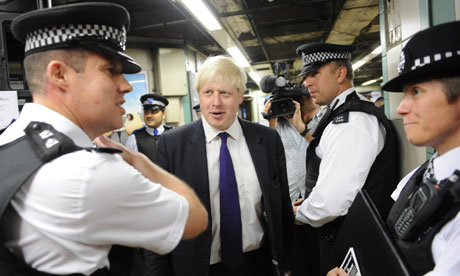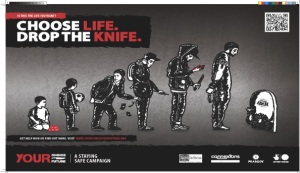 |
| Mayor of London, Boris Johnson - pays only lip service to race issues. |
Boris Johnson today announced a ‘review’ into racism in the Metropolitan Police Service in recognition that under his watch, racist is resurgent and out of control and as a consequence the relationship of the MPS and London black communities is the worst we have seen in years.
This ‘inquiry’ the details of which are as yet unknown will, it’s said, look at the implementation of the discredited ‘Race & Faith Report’ published and then subsequently ditched in August 2012. Published some 18 months late in the middle of the summer holidays, the report was instantly forgotten by all. The report was a joke and I wrote a damning article about this at the time.
The credibility of the report that focused entirely on the issues of recruitment, retention and promotion of black officers was deeply compromised. In essence this report was politically hijacked by Boris Johnson and the then Police Commissioner Kit Malthouse, both of whom were determined to ensure that the findings concluded that the “MPS was no longer institutionally racist”.
The then inquiry team one of whom resigned in protest heavily resisted that finding. The report itself did not reach any such conclusion, however the Mayor insisted that the following passage referring to ‘institutional racism’ was inserted into the report
“Now, however, as a consequence of rhetorical inflation, the term is used too glibly as a blanket indictment and as such has become a barrier to reform. Paradoxically the concept of institutional racism has become a millstone around the neck of the MPS, obscuring our understanding of the nature of any continuing endemic racism in that or any other large organisation.”
The Mayor made a serious error in seeking to dismiss the reality of ‘institutional racism’ and that would cost London and the rest of the country dear, as within a year of the publication of the Race & Faith report London exploded in violence at the shooting by the MPS of Mark Duggan.
The Race & Faith report was a real missed opportunity. Ironically today, in his desperation to be seen to responding to huge concern about race and policing, in a media driven reflex action he has now decided to conduct a review on the implementation of a series of recommendations that, at the time of publicising, he had no real intention of implementing. A new ‘review’ that focuses on the discredited narrow employment focused recommendations of the Race & Faith report which demonstrates a deliberately confused knee jerk political response that fails to recognise the scale of the problem.
The truth here is that the Mayor pays nothing but lip service to tackling racism in the MPS. He sees these issues as just another opportunity to grab headlines and is forever in search of cosmetic solutions.
This problem was exemplified today as the ‘review’ was announced at the meetings of the GLA Police and Crime Committee. Both the Mayor and the Commissioner answered questions from London Assembly members. Today when asked questions about the review (that unsurprisingly was first announced in the press) Boris stated he thought the review had already started whilst the Commissioner claimed he did not know anything about it.
The acute political deficit and confusion at City Hall in understanding London’s multiculturalism and anti racism does not stop there. It extends up the Thames right up to New Scotland Yard.
In February this year I challenged Commissioner Hogan Howe publically to accept that relations between London’s Black Community and the MPS was the worst it had been in 30 years.
I put it to the Commissioner that “The MPS has lost the confidence of black communities through massive year on year increases in stop and search and controversial deaths in police custody. How are you going to repair and restore confidence”?
Commissioner Hogan-Howe replied: “I disagree with almost everything you have said.”
Further the political co-option of Operation Trident originally set up specifically to tackle gun crime in black communities and bastardised into a London wide anti gang unit, clearly illustrates that in the eyes of the Mayor and the MPS Commissioner, London’s gang problem is in essence a black community problem. Trident is fatally compromised as a result.
The riots of August 2011 and the current deluge of racist incidents within the MPS and the reluctant acceptance of both the Mayor and now the Commissioner that there is a need for another ‘review’ does not represent a serious effort to get to the root of the problem of endemic institutional and cultural racism within the MPS. The confusion around its launch today demonstrates the cynical politicking of the Mayor’s Office.
The Mayor over the last two years and the Commissioner of late have both refused to accept that there was a profound crisis of trust and confidence between London’s black communities and the MPS. They consistently denied there was a problem and when the August 2010 riots erupted they were spectacularly unprepared and did not have the political or professional capacity to respond, leaving London and the country twisting on the wind.
Once again I can forewarn them that playing politics with the issue of race and policing is a dangerous and deadly game. This summer will see tensions rise again as result of deaths in custody Inquest hearings that will dramatically increase tensions and the 2012 Olympics that will see aggressive increases in stop and search figures. That’s not including any catalyst events that will no doubt take place in addition to a black youth unemployment rate that is now 56%.
I believe, that in an effort to begin the process of restoring trust and confidence, the London Assembly Police and Crime Committee should organise public consultations as matter of urgency if we are to avoid further disturbances on the streets of London.
Boris Johnson now has sole power over the MPS, He can decide under the new powers given to him to initiate widespread and fundamental reforms of the MPS. He could use these powers to good effect.
The Mayor could establish a judicial public inquiry into suspicious deaths in custody. He has the power to do so under the GLA Act. He could agree to attend a round of public consultations organised by London’s black communities (GLA organised consultations are poorly attended and are stage managed) in an effort to identify the real reality of racism of policing.
He could establish a judicial inquiry into the potential police corruption of the Stephen Lawrence Inquiry as demanded by Doreen Lawrence.
He could insist, as I did whilst in post, that all MPS recruitment over a period of three years focuses solely on advertising targeting black and ethnic minorities resulting in the biggest increase number of black police officers recruited ever seen in the history of the MPS.
He could demand that the MPS immediately settle all outstanding internal and external race complaints from serving officers and members of the public saving the taxpayer millions of pounds in legal fees and years of tortuous grief endured by public complainants.
He could insist that the MPS set out a draft race equality strategy for consultation. He could insist that all DNA of people not charged with a crime are removed form the police database.
He could insist that stop and search numbers come down just as he insisted in 2008 that they went up.
These are just a few things he has in his power to do. This ‘coulda, woulda, shoulda’ Mayor has a proved to be a disaster for race relations in London.
The recent Mayoral elections demonstrate that his stance on race is the very thing that is an attraction for some Londoners, who understand and agree with his ideological opposition to the principle of race equality. For a city like London that is a catastrophic error borne of prejudice and ignorance and one that will cost the City dear.


















